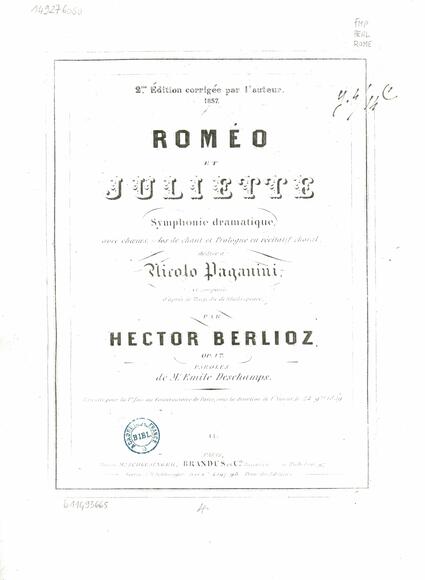Roméo et Juliette op. 17

“Symphonie dramatique” in three parts and a finale.
PART ONE
INTRODUCTION
1. Combats (Fighting) – Tumulte (Tumult) – Intervention du prince (Intervention by the prince)
PROLOGUE
2. Choral Recitative: “D’anciennes haines endormies”
3. Strophes: “Premiers transports que nul n’oublie!”
4. Recitative and Scherzetto: “Bientôt de Roméo la pâle reverie”
PART TWO
1. Roméo seul (Romeo alone) – Tristesse (Sadness) – Bruits lointains de concert et de bal (Distant sounds from the concert and the ball) – Grande fête chez Capulet (Banquet at the Capulets' house)
2. Scène d’amour (Love scene): Nuit sereine (Tranquil night) – Le jardin de Capulet silencieux et désert (The silent deserted garden of the Capulets) – Les jeunes Capulets sortant de la fête passent en chantant des réminiscences de la musique du bal (The young Capulets leaving the banquet pass by singing snatches of music from the ball)
3. Scherzo: La reine Mab, ou la fée des songes (Queen Mab, or the dream fairy)
PART THREE
4. Convoi funèbre de Juliette (Funeral procession for Juliet): “Jetez des fleurs pour la vierge expirée”
5. Roméo au tombeau des Capulets (Romeo in the Capulets’ tomb): Invocation – Réveil de Juliette (Juliet awakes) – Joie délirante, désespoir (Rapturous joy, despair) – Dernières angoisses et mort des deux amants (Final throes and death of the two lovers)
FINALE
La foule accourt au cimetière – Rixe des Capulets et des Montaigus (The crowd hurries to the cemetery – Brawl between the Capulets and the Montagues)
Récitatif et air du père Laurence – Serment de réconciliation (Recitative and aria by Friar Lawrence – Sermon about reconciliation)
1. Chorus and Recitative by Friar Lawrence
2. Aria: “Pauvres enfants que je pleure”
3. “Jurez donc par l’auguste symbole”
Although Paganini never played Harold en Italie, he gave its composer 20,000 francs after hearing him conduct this “Symphony with viola obbligato” along with the Symphonie fantastique on 16 December 1838. The financial ease conferred by this gift allowed Berlioz to compose Roméo et Juliette, which received a triumphant premiere on 24 November 1839. This is Berlioz’s interpretation of the play which had bowled him over in 1827 (Harriet Smithson, his future wife, had performed the role of Juliet). His “Symphonie dramatique” based on a libretto by Émile Deschamps after the version by Garrick, does not follow Shakespeare’s text slavishly, since it moves episodes around, cuts some (particularly the comic scenes) and shortens others. It shows the composer’s liking for fragmented plots which include a number of ellipses. Combining movements with solo singers (who embody secondary characters since neither Romeo nor Juliet sing), with others dominated by the chorus as well as purely orchestral sequences, this work is a symphony, ode-symphony, symphonic poem, secular cantata and – in the final scene – opera and oratorio rolled into one. The music is also remarkable for combining fugue and psalmody (Convoi funèbre de Juliette). It anticipates the wandering chromaticism of Wagner’s Tristan und Isolde (Roméo seul), and rivals Mendelssohn in the genre of the fairy scherzo (La reine Mab). The entirely orchestral Scène d’amour was to influence Liszt, Wagner and Tchaikovsky, which clearly shows the impact of this unclassifiable work.


